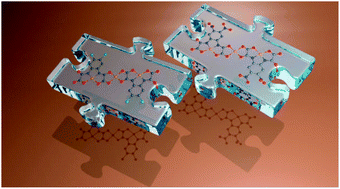Discrete trinuclear copper(ii) compounds as building blocks: the influence of the peripheral substituents on the magnetic coupling in oxamato-bridged complexes†
Abstract
Two new trinuclear copper(II) complexes without end-capping ligands, (Bu4N)2[Cu(dmso)2{Cu(dnopba)(dmso)}2] (1) and (Bu4N)2[Cu(dmso)2{Cu(dcopba)(dmso)}2] (2) [dnopba = 4,5-dinitro-ortho-phenylenebis(oxamate), dcopba = 4,5-dichloro-ortho-phenylenebis(oxamate), Bu4N+ = tetra-n-butylammonium and dmso = dimethylsulfoxide], were synthesized and their structures were determined by single crystal X-ray diffraction. The crystal structures of 1 and 2 consist of two outer bis(oxamato)(dmso)cuprate(II) units which act as bidentate ligands toward a trans-bis(dmso)copper(II) inner entity leading to centrosymmetric tricopper(II) complexes with copper–copper separations across the oxamate bridges of 5.1916(3) (1) and 5.1776(3) Å (2). The peripheral copper(II) ions in 1 and 2 are five-coordinate in somewhat distorted square pyramidal environments with a dmso molecule filling the apical position whereas the inner copper(II) ion is six-coordinate in an elongated octahedral environment with two dmso molecules in the axial sites. The investigation of their magnetic properties in the temperature range 2.0–300 K shows the occurrence of a strong intramolecular antiferromagnetic coupling between the copper(II) ions through the oxamate bridges [J1 = −296(1) (1) and −334(1) cm−1 (2), the Hamiltonian being defined as Ĥ = −J1(ŜCu2·ŜCu1 + ŜCu2·ŜCu1′)], which leads to a low-lying spin doublet at low temperatures. Density functional theory calculations (DFT) have been used to substantiate these magnetic couplings and also to analyse the influence exerted on these interactions by the type of substituent at the 4,5-positions from the phenylene ring of the bis(oxamate) ligand.


 Please wait while we load your content...
Please wait while we load your content...